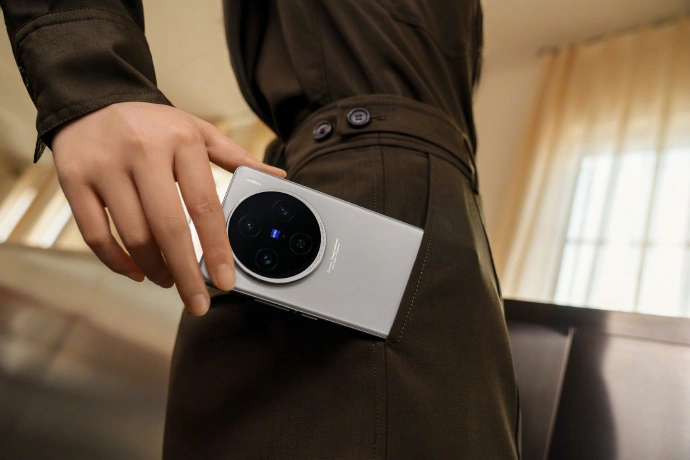Vivo recently unveiled its latest flagship lineup in China, with the X100s being one of the contenders. But how does this new challenger stack up against the Vivo X100, released in late 2023? Let’s take a deep dive into the specifications, design, camera systems, and other aspects to see which phone might be the better choice for you.

1. Display and Design
Both models boast a 6.78-inch display, but they differ in terms of screen design. The Vivo X100s features a flat 8T LTPO OLED display with a resolution of 2800 × 1260 pixels and supports a 120Hz refresh rate. It stands out with its ability to deliver 10-bit colors, covering 100% of the DCI-P3 color space and achieving a peak brightness of 3,000 nits. Additionally, the X100s uses 2160Hz high-frequency PWM dimming to reduce screen flicker, which is especially beneficial under low-light conditions.
On the other hand, the Vivo X100 uses a curved 8T LTPO 120Hz AMOLED display that also supports HDR10+ for enhanced color and contrast. Although both models share the same peak brightness and color depth, the curved design of the X100 might appeal more to users who enjoy a more immersive display experience. However, some users may find them prone to accidental touches.
2. Performance
The X100s takes the lead in processing power. It’s equipped with the latest MediaTek Dimensity 9300+ SoC, a slightly overclocked version of the Dimensity 9300 found in the X100. This translates to potentially better performance, especially in demanding tasks and games. Both phones offer 12GB or 16GB of LPDDR5X RAM, ensuring smooth multitasking. Storage options are identical, with configurations ranging from 256GB to 1TB using the faster UFS 4.0 standard.
3. Cameras
Photography is a major focus with both devices offering a similar camera setup. The X100s sports a triple rear camera system featuring a 50MP super-sensitive bionic main camera with an f/1.57 aperture, a 64MP Zeiss super telephoto camera with an f/2.57 aperture, and a 50MP ultra-wide camera. It also includes advanced features like a V2 imaging chip, OIS anti-shake technology, and up to 100x digital zoom.
In contrast, the X100 also includes a 50MP main camera with f/1.57 aperture, a 50MP 150° ultra-wide-angle camera, and a 64MP telephoto camera with f/2.57 aperture that also supports OIS and up to 100x digital zoom. Both models use Zeiss T* coating for improved optical performance. For selfies and video calls, both these devices include 32MP front-facing cameras.
We can’t really compare these cameras based on the specs. Only real-world usage can give a detailed opinion on this.
4. Software and Battery
Both smartphones run on Vivo’s OriginOS 4, based on Android 14, offering a similar software experience with features like Jovi voice assistant and various smart connectivity options.
In terms of charging, the X100s boasts a larger 5100mAh battery compared to the X100’s 5000mAh battery. While the difference may seem small, it could translate to slightly longer battery life on the X100s. However, the X100 edges out the X100s in charging speed with its 120W fast charging, capable of reaching 50% in just 11 minutes. The X100s offers 100W wired charging, still very fast, but not quite as rapid as the X100.
5. Dimensions and Durability
The X100s is slightly thinner and lighter than the X100. The X100s measures 7.8mm and weighs 203g, while the X100 comes in at 8.49mm and 206g. The X100s also boasts a more unique flat display design, whereas the X100 retains the curved display design of its predecessor. Both phones offer IP ratings for dust and water resistance. The X100s goes a step further with an IP69 rating, indicating it can withstand high-pressure water jets, making it potentially more durable in extreme conditions.
6. Pricing
The starting price for both phones is identical at 3,999 yuan ($552) for the 12GB + 256GB variant. However, the X100 becomes slightly more affordable for the higher storage options. Here’s a quick comparison:
12GB + 256GB: Same price (3,999 yuan)
16GB + 256GB: X100s is slightly more expensive (4,399 yuan vs 4,299 yuan)
16GB + 1TB: X100 is cheaper (4,999 yuan vs 5,199 yuan)
16GB + 1TB (LPDDR5T RAM): X100’s most expensive option (5,099 yuan)
7. Conclusion
Both the Vivo X100s and X100 are excellent flagship smartphones with high-end features. The choice ultimately depends on your individual needs and priorities. If raw processing power and a flat display are most important, the X100s is a compelling option. However, if you prioritize a curved display or the fastest charging speeds, the X100 might be a better fit. Consider the weight and dimensions of each phone as well, to see which feels more comfortable in your hand.
You can also check out the detailed comparison of X100s Pro vs X100 Pro.
RELATED:
- IDC Q1 2024: Vivo leads Indian smartphone market followed by Samsung, Poco surpasses OnePlus
- Vivo Watch 3 ECG version debuts in China with a premium look
- Samsung Galaxy Watch 6 Classic is up for grabs at a jaw-dropping price
- Redmi 12 5G Available Under Rs 10,000 With A Coupon Offer For Limited Period
- HyperOS vs MIUI: 10 Things You Must Know







